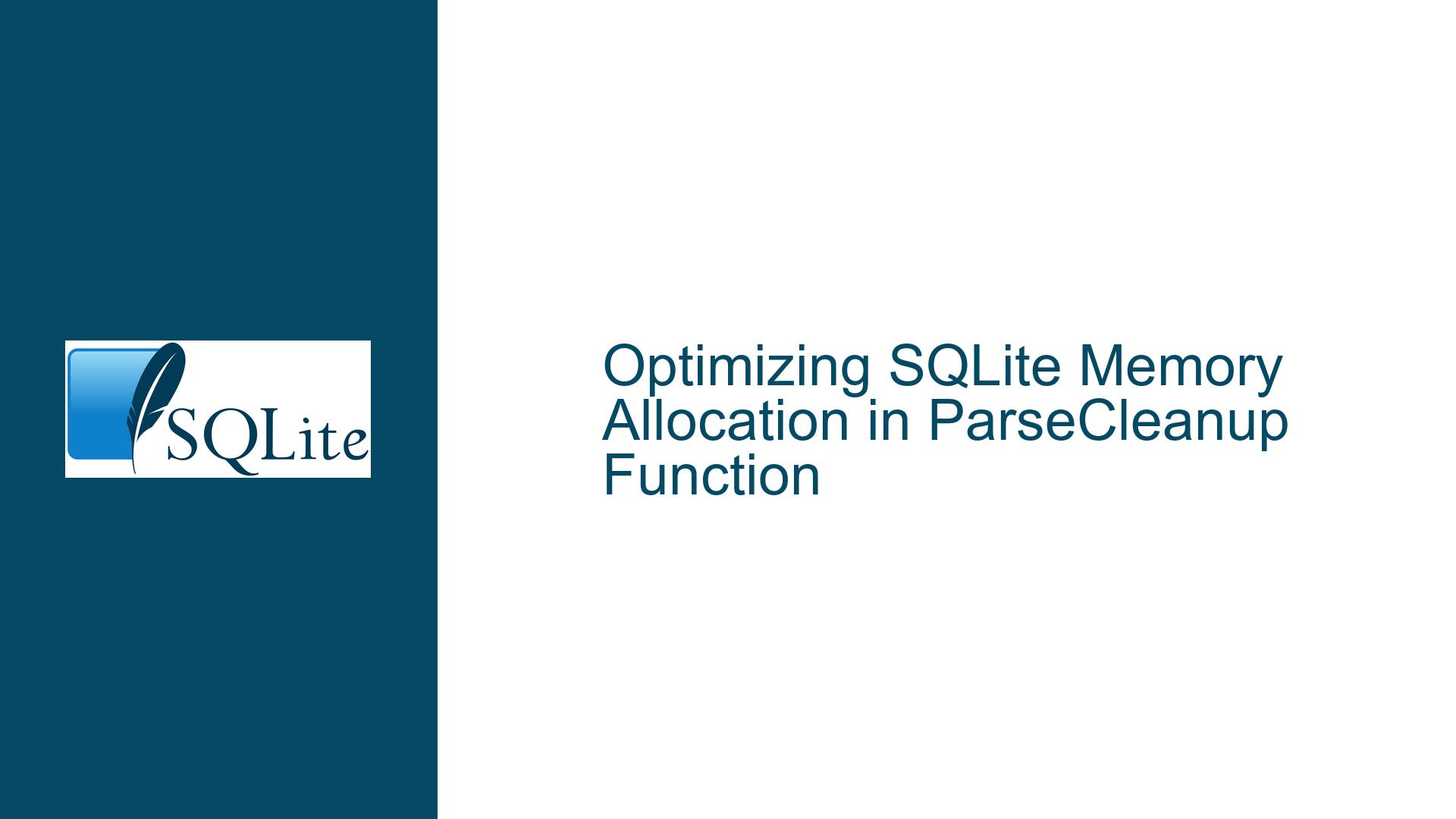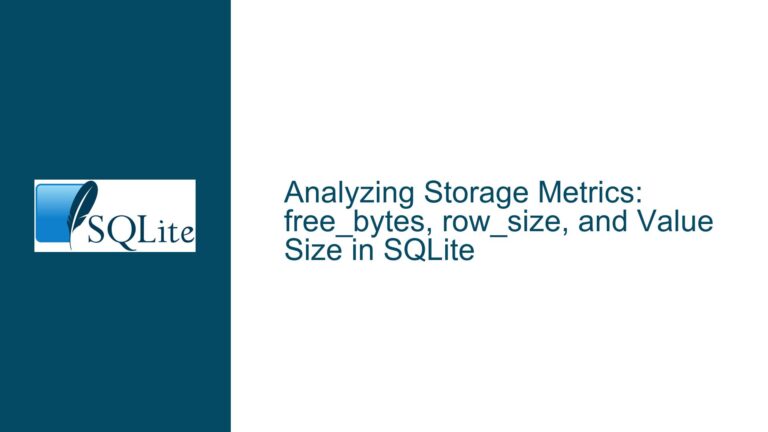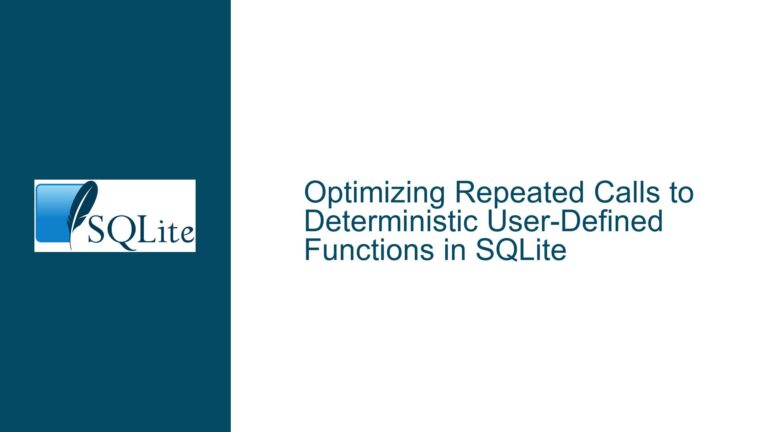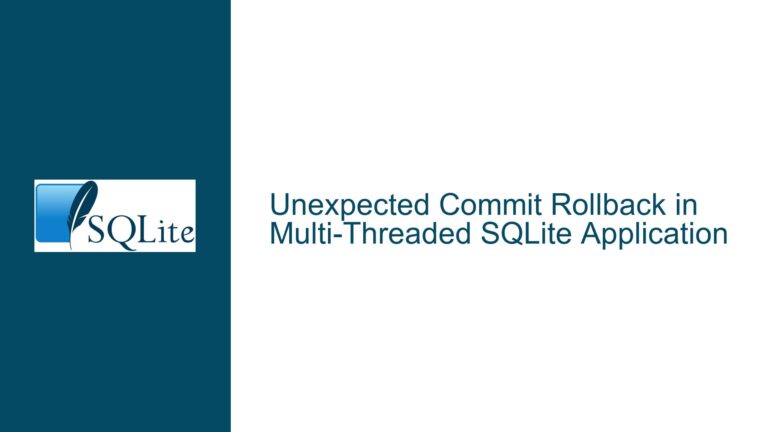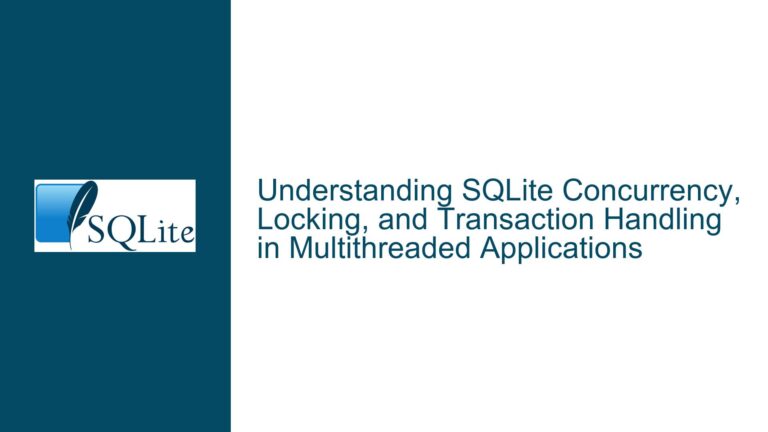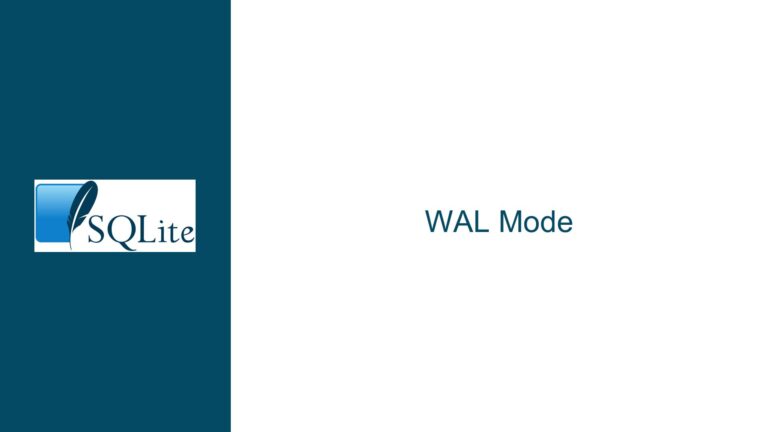Optimizing SQLite Memory Allocation in ParseCleanup Function
Memory Allocation Overhead in SQLite’s ParseCleanup Mechanism
The core issue revolves around the memory allocation strategy used in SQLite’s sqlite3ParserAddCleanup function, which is responsible for managing cleanup tasks after parsing SQL statements. The original implementation allocates memory for each individual cleanup task, leading to potential inefficiencies due to frequent calls to sqlite3DbMallocRaw. This can result in increased memory fragmentation and overhead, especially in scenarios where multiple cleanup tasks are registered during the parsing phase.
The patch introduces a new approach by grouping cleanup tasks into arrays, reducing the number of memory allocations. This is achieved by introducing two new structures: ParseCleanupHdr and ParseCleanupTask. The ParseCleanupHdr structure acts as a header for an array of ParseCleanupTask objects, allowing multiple tasks to be managed under a single memory allocation. This change aims to optimize memory usage and reduce the frequency of memory allocations, which can be particularly beneficial in environments with limited resources or high-performance requirements.
The ParseCleanupHdr structure contains metadata about the array of tasks, including the number of used tasks (nTask), the number of allocated task slots (nSlot), and a pointer to the next cleanup header (pNext). Each ParseCleanupTask object within the array holds a pointer to the object to be cleaned up (pPtr) and a function pointer to the cleanup routine (xCleanup). This reorganization allows for more efficient memory management by reducing the number of individual allocations and deallocations.
Frequent Memory Allocations and Fragmentation in ParseCleanup
The primary cause of inefficiency in the original implementation is the frequent allocation of small memory blocks for each cleanup task. Each call to sqlite3ParserAddCleanup results in a separate memory allocation for a ParseCleanup structure. This can lead to memory fragmentation, where the available memory becomes divided into small, non-contiguous blocks, making it difficult to allocate larger contiguous blocks of memory when needed.
Memory fragmentation can degrade performance over time, as the memory allocator may need to search for suitable blocks or even trigger garbage collection processes to consolidate free memory. In addition, the overhead of managing numerous small allocations can become significant, especially in scenarios where the number of cleanup tasks is large. This is particularly problematic in SQLite, which is often used in embedded systems or applications where memory resources are limited.
The patch addresses this issue by introducing a mechanism to group multiple cleanup tasks into a single memory allocation. By allocating a larger block of memory that can hold multiple ParseCleanupTask objects, the number of individual allocations is reduced. This approach not only minimizes memory fragmentation but also reduces the overhead associated with managing multiple small memory blocks. The use of a header structure (ParseCleanupHdr) to manage these arrays further enhances efficiency by providing a clear and organized way to track and manage the cleanup tasks.
Another potential cause of inefficiency in the original implementation is the lack of reuse of previously allocated memory blocks. Each cleanup task is allocated and deallocated independently, without any attempt to reuse memory that has been freed. This can lead to unnecessary memory churn, where the same memory is repeatedly allocated and freed, further exacerbating fragmentation and overhead.
The patch mitigates this by allowing for the reuse of memory slots within the allocated arrays. When a new cleanup task is added, the function first checks if there is available space in the existing array of tasks. If space is available, the new task is added to the existing array, avoiding the need for a new memory allocation. This reuse of memory slots helps to further reduce the number of allocations and deallocations, leading to more efficient memory usage.
Implementing Array-Based Cleanup Task Management
To address the inefficiencies in the original implementation, the patch introduces a new approach to managing cleanup tasks using arrays. This approach involves several key changes to the sqlite3ParserAddCleanup function and the introduction of new data structures (ParseCleanupHdr and ParseCleanupTask).
The first step in the new implementation is to check if there is an existing ParseCleanupHdr structure with available space for additional tasks. This is done by examining the nTask and nSlot fields of the ParseCleanupHdr structure. If there is available space, the new task is added to the existing array of tasks, and the nTask field is incremented to reflect the addition of the new task.
If there is no available space in the existing array, a new ParseCleanupHdr structure is allocated, along with an array of ParseCleanupTask objects. The size of the array is determined by the nSlotMin constant, which is set to 7 in the patch. This constant represents the minimum number of task slots to allocate, ensuring that the new array has sufficient space to accommodate multiple tasks. The actual number of slots allocated may be larger, depending on the size of the memory block returned by sqlite3DbMallocRaw.
Once the new ParseCleanupHdr structure and task array are allocated, the new task is added to the array, and the nTask and nSlot fields are initialized accordingly. The pNext field of the ParseCleanupHdr structure is set to point to the previous cleanup header, creating a linked list of cleanup headers. This allows the function to traverse the list of cleanup headers and perform the necessary cleanup tasks when the parsing process is complete.
The cleanup process itself is also modified to take advantage of the new array-based approach. Instead of processing each cleanup task individually, the function now iterates over the array of tasks within each ParseCleanupHdr structure. This reduces the overhead associated with traversing the linked list of cleanup tasks and allows for more efficient processing of the cleanup operations.
The following table summarizes the key differences between the original and patched implementations:
| Aspect | Original Implementation | Patched Implementation |
|---|---|---|
| Memory Allocation | Allocates memory for each cleanup task | Allocates memory in arrays for multiple tasks |
| Memory Fragmentation | High due to frequent small allocations | Reduced due to fewer, larger allocations |
| Task Management | Linked list of individual tasks | Array of tasks within a header structure |
| Reuse of Memory | No reuse of memory blocks | Reuse of memory slots within arrays |
| Cleanup Process | Processes tasks individually | Processes tasks in batches within arrays |
The new implementation also includes additional assertions and checks to ensure the correctness of the memory management. For example, the patch includes an assertion to verify that the number of tasks (nTask) is always greater than zero and does not exceed the number of allocated slots (nSlot). This helps to catch any potential issues with memory management early, reducing the risk of memory corruption or other errors.
In addition to the changes to the sqlite3ParserAddCleanup function, the patch also updates the Parse structure to use the new ParseCleanupHdr structure instead of the original ParseCleanup structure. This change ensures that the rest of the SQLite codebase is compatible with the new memory management approach and can take advantage of the improved efficiency.
Overall, the patch represents a significant improvement in the way SQLite manages memory for cleanup tasks during the parsing process. By reducing the number of memory allocations and reusing memory slots, the new implementation minimizes memory fragmentation and overhead, leading to more efficient memory usage and better performance, particularly in resource-constrained environments.
The following steps outline the key changes and their impact:
Introduction of
ParseCleanupHdrandParseCleanupTaskStructures: These new structures allow for the grouping of cleanup tasks into arrays, reducing the number of memory allocations and improving memory management efficiency.Modification of
sqlite3ParserAddCleanupFunction: The function now checks for available space in existing arrays before allocating new memory, reducing the frequency of memory allocations and allowing for the reuse of memory slots.Batch Processing of Cleanup Tasks: The cleanup process is updated to process tasks in batches within arrays, reducing the overhead associated with traversing a linked list of individual tasks.
Additional Assertions and Checks: The patch includes additional assertions to ensure the correctness of the memory management, reducing the risk of memory corruption or other errors.
Compatibility Updates: The
Parsestructure is updated to use the newParseCleanupHdrstructure, ensuring compatibility with the rest of the SQLite codebase.
By implementing these changes, the patch addresses the inefficiencies in the original implementation and provides a more robust and efficient approach to managing cleanup tasks in SQLite. This can lead to improved performance and reduced memory usage, particularly in environments where resources are limited or where high performance is critical.
